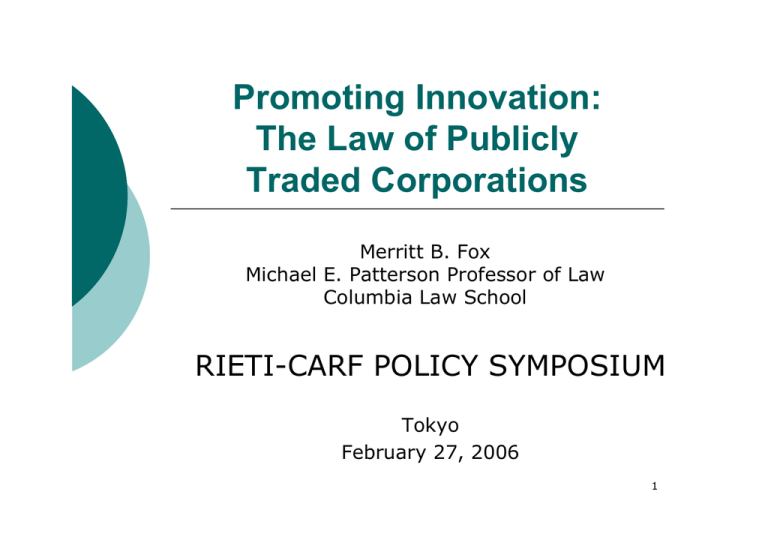Promoting Innovation: The Law of Publicly Traded Corporations RIETI-CARF POLICY SYMPOSIUM
advertisement

Promoting Innovation:
The Law of Publicly
Traded Corporations
Merritt B. Fox
Michael E. Patterson Professor of Law
Columbia Law School
RIETI-CARF POLICY SYMPOSIUM
Tokyo
February 27, 2006
1
Ultimate Real Economy Goal
¾
¾
¾
Match scarce savings with the most
promising investment projects
Highly promising projects typically
innovation based
Financing innovation based projects
thus needs special attention
2
Spin-offs
One or a group of employees of an
established firm leave to form a
new firm based on an idea
developed while in their previous
employment
3
Spin-offs are Vital to Implementation
of Innovative Projects
Employees of large, established firms are a
rich source of innovative project proposals
z
large firm’s physical and organizational assets
facilitate discoveries
Established firms often fail to implement
promising project proposals
z
large portion of most important U.S. innovation
based firms grew out of spin-offs
Spin-offs represent established firm finance
failures: without spin-offs, highly promising
project proposals would go to waste
4
The Spin-off Phenomenon Has Important
Implications for the Structure and Allocation of
Investment Decisionmaking in the Economy
Minimize the number of promising
proposals passed up by established firms
z
Requires discipline of established firm
managers
Maximize the number promising spin-off
proposals that are financed
z
Requires the facilitation of venture capital
Regulation of public equity markets is
relevant to both concerns
5
Existing Literature on Spin-offs
Spin-offs typically receive their initial
financing from a venture capitalist, not
from a public offering of shares.
Focus of the existing literature:
z
z
the optimal contract between the venture
capitalist and the entrepreneur
constraints on would-be entrepreneurs by rules
relating to intellectual property
6
Role of Public Equity Markets Comes in
“Through the Back Door:”
Black & Gilson
{
{
{
Thesis that the optimal contract is structured
around the availability of the venture capitalist’s
exit through an IPO.
Used to explain why innovation based spin-offs
occur in much greater numbers in the United
States than in Germany or Japan.
Theory: more “vibrant” public equity market in
the United States makes this optimal form of
venture capital contract more available in the
United States than elsewhere.
7
Black & Gilson’s Focus on “Vibrant”
Public Equity Markets Underdeveloped
{
{
Public equity markets not only need
to have substantial scale and high
liquidity
Need to be well functioning as well,
i.e., have relatively accurate prices
and transparency
8
Issues Addressed
How established firms fail to implement
innovative project proposals developed by their
employees
Role of well functioning equity markets
z
in reducing the number of opportunities missed by
established firms
z
in forcing the payout of cash flow when these
opportunities are missed
z
in steering venture capital to the most promising
spin-off proposals
Role of securities regulation in promoting well
functioning equity markets
9
Established Firm Finance Pathology #1
Failure to identify positive NPV
projects that the firm is particularly
well positioned to develop
z
incentive tradeoffs between idea
development and idea identification
z
organizational blind spots from
established modes of information
processing
10
Established Firm Finance Pathology # 2
Failure to implement positive net present
value project that firm does identify
z
managers reject a positive net present value
project to avoid personal risk
Reason: innovative projects tend to have
high unsystematic risk.
z
z
managers avoid because they cannot diversify
away the unsystematic risk
shareholders and society as a whole risk
neutral with respect to such risks.
11
Established Firm Finance Pathology # 3
Use of internally generated cash flow to invest in
new negative net present value projects
Reason: managerial preference for firm growth
stronger than for maximizing share value.
Perverse interactions with Pathologies #1 and #2:
z
passing up innovative positive net value projects
leaves more cash flow to invest in negative net
present value projects if that is the only way to
maximize growth
Offering-registration-based disclosure regulation
and dividend taxes also contribute
12
Schools of Thought Concerning
Importance of Share Price Accuracy for
the Real Economy
¾
¾
¾
Irrelevant for theoretical reasons
(Banoff, Romano)
Irrelevant for institutional reasons
(Stout)
Relevant for theoretical reasons
(Coffee, Fox, Kahan, Mahoney)
13
Irrelevant for Theoretical Reasons
EMH assures that prices will be unbiased
and hence fair
Under CAPM
¾
¾
Changes in share price accuracy only affect
unsystematic risk
Market does not reward changes in
unsystematic risk so increased share price
accuracy is not welfare enhancing
14
Implicit View Behind the Theoretical
Irrelevance Position
Equity is simply as a place for
investors to store wealth
The social function of the stock
market
¾
Facilitate the trading of financial assets,
hedging, diversification, and pooling of
risk
15
Irrelevant for Institutional Reasons
¾
¾
Acknowledges the theoretical
argument that share price accuracy
benefits the real economy
Dismisses the importance of this
effect due to the institutional reality
that only a small portion of all new
real investment is funded by public
offerings of equity
16
Relevance Arguments
Share price accuracy significantly
affects:
¾
¾
Choice among new proposed real
investment projects in the economy
The operation of existing real assets
Theoretical irrelevance position’s
focus only on the risk allocation
function of securities markets is too
narrow
17
Greater Price Accuracy in the Primary Market
Produces Social Benefits Directly.
For issuer share offerings to finance a
new project
z
z
more accurate prices bring the issuer’s cost of
capital closer to the opportunity cost of
investing society’s scarce savings
this improves the extent to which scarce
savings are matched with the most promising
projects
18
Primary Market, cont.
For spin-off venture capital
z
z
the prospect that the best spin-off ventures ex
post will be identified more accurately at time
of the venture capitalist’s exit adds to its
incentive ex ante to find the best spin-off ideas
to fund.
also gives more resources for reinvestment in
new spin-offs to those venture capitalists who
chose good spin-offs in the past
19
Greater Price Accuracy and
Transparency in the Secondary Market
Produces Social Benefits Indirectly.
Assists the social devices that limit the
extent to which managers of established
public corporations place their own
interests above those of their
shareholders (the agency costs of
management)
Thus it reduces the three established firm
“pathologies”
20
Secondary Market, cont.
Specifically, increased share price accuracy and
transparency enhances effectiveness of
z
z
z
Shareholder franchise and shareholder enforcement
of management’s fiduciary duties, by signaling
where problems
Threat of hostile takeover when managers engage
in non-share-value-maximizing behavior, by making
takeovers less risky for potential acquirers
share price based management compensation, by
reducing the riskiness associated with holding an
issuer’s stock in a less than fully diversified portfolio
and thus increasing management willingness to
take a larger portion of compensation in this form
21
Institutional Skeptics Have
Too Narrow a Perspective
Ignore indirect effects of more accurate
prices in secondary markets
z
especially important for funding innovation
through spin-offs since biggest agency cost is
overretention of cash flow and investment in
negative NPV projects
More accurate secondary market prices
also improve capital allocation when an
established firm uses non-equity external
sources of capital such as borrowings and
debt offerings
22
Role of Mandatory Disclosure
Without regulation: issuers will disclose at a
suboptimally low level because of externalities
Private costs of disclosure greater than social
costs
z
competitors, major customers, major suppliers
Private benefits of disclosure less than social costs
z
usefulness of one firm’s disclosure in assessing
others
23
Structure of Sanctions for Violations
Rules without sanctions irrelevant
z
civil liability a helpful sanction
Sanctions should not penalize
choice to finance externally
z
otherwise, there is an incentive for
internal finance which hurts innovation
24
Conclusions
{
{
Well functioning public equity
markets are important for
promoting innovation even though
much innovative investment is
financed by private equity
Properly designed disclosure
regulation needed for public
markets to function well
25



